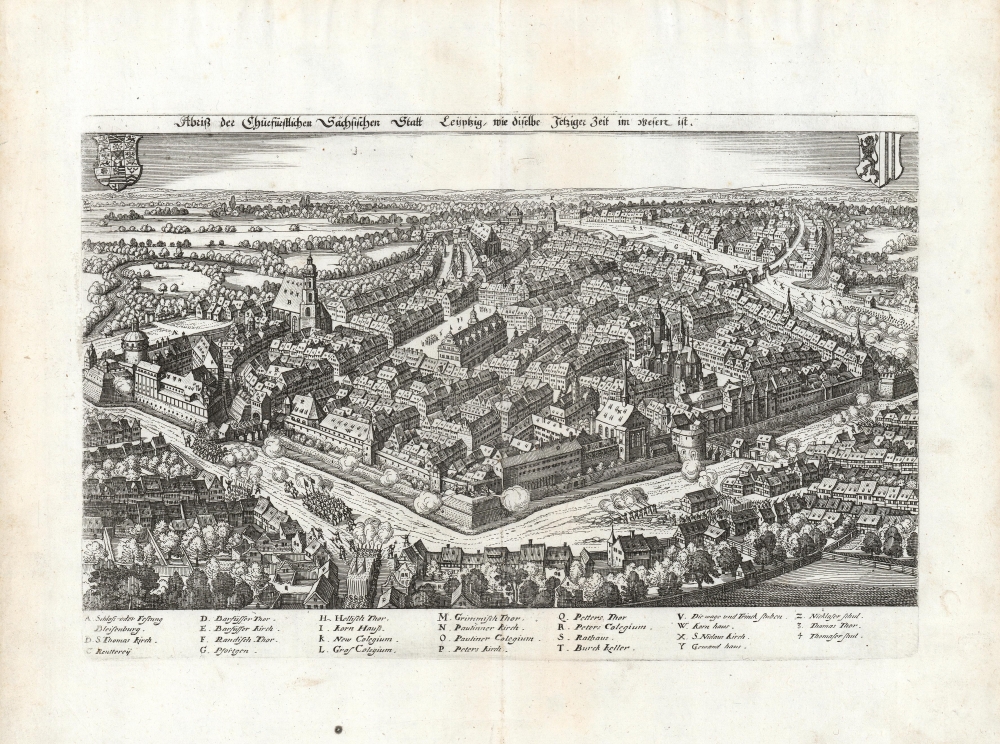1638 Bird's Eye View of the 1631 Siege of Leipzig
Leipzig-merian-1638
Title
1638 (undated) 8 x 12.5 in (20.32 x 31.75 cm)
Description
A Closer Look
The walled city and its suburbs are vividly portrayed. 26 key structures - primarily churches and forts - are letter-keyed to a legend at the bottom of the view. Soldiers stream towards the fortifications and are met before the gates amid the smoke of musket-fire. Leipzig belonged to the Electorate of Saxony, which had sided with Sweden in the war against the Holy Roman Empire. It is the Imperial army, led by the Count of Tilly, besieging the city in this view.1631 Siege of Liepzig
The 1631 Siege of Leipzig occurred during the Thirty Years' War (1618 - 1648), a protracted conflict involving most of the great powers of Europe. The Swedish forces, led by King Gustavus Adolphus, laid siege to Leipzig, defended by forces loyal to the Holy Roman Empire. Despite fierce resistance, the Swedes ultimately captured the city after a relentless weeks-long bombardment. This victory was significant for Protestant forces and marked a turning point in the war. It weakened Habsburg regional hegemony and allowed Swedish forces to advance deeper into Central Europe. The Siege of Leipzig is notable not only for its strategic significance but also for the innovations in military tactics and weaponry employed by the Swedish forces, which would influence the conduct of warfare in the subsequent decades.Publication History and Census
This view was created by Matthaus Merian and appeared in his 1638 Archontologia cosmica. It may have been intended for inclusion in his 1633 Theatrum Europaeum, but we do not see it in digitized examples of that work. Nine examples are listed in OCLC.Cartographer
Matthäus Merian (September 22, 1593 - June 19, 1650), sometimes referred to as 'the Elder' to distinguish from his son, was an important Swiss engraver and cartographer active in the early to mid 17th century. Merian was born in Basel and studied engraving in the centers of Zurich, Strasbourg, Nancy and Paris. In time Merian was drawn to the publishing mecca of Frankfurt, where he met Johann Theodor de Bry, son of the famed publisher Theodor de Bry (1528 - 1598) . Merian and De Bry produced a number of important joint works and, in 1617, Merian married De Bry's daughter Maria Magdalena. In 1623 De Bry died and Merian inherited the family firm. Merian continued to publish under the De Bry's name until 1626. Around this time, Merian became a citizen of Frankfurt as such could legally work as an independent publisher. The De Bry name is therefore dropped from all of Merian's subsequent work. Of this corpus, which is substantial, Merian is best known for his finely engraved and highly detailed town plans and city views. Merian is considered one of the grand masters of the city view and a pioneer of the axonometric projection. Merian died in 1650 following several years of illness. He was succeeded in the publishing business by his two sons, Matthäus (1621 - 1687) and Caspar (1627 - 1686), who published his great works, the Topographia and Theatrum Europeaum, under the designation Merian Erben (Merian Heirs). Merian's daughter, Anna Maria Sibylla Merian, became an important naturalist and illustrator. Today the German Travel Magazine Merian is named after the famous engraver. More by this mapmaker...

